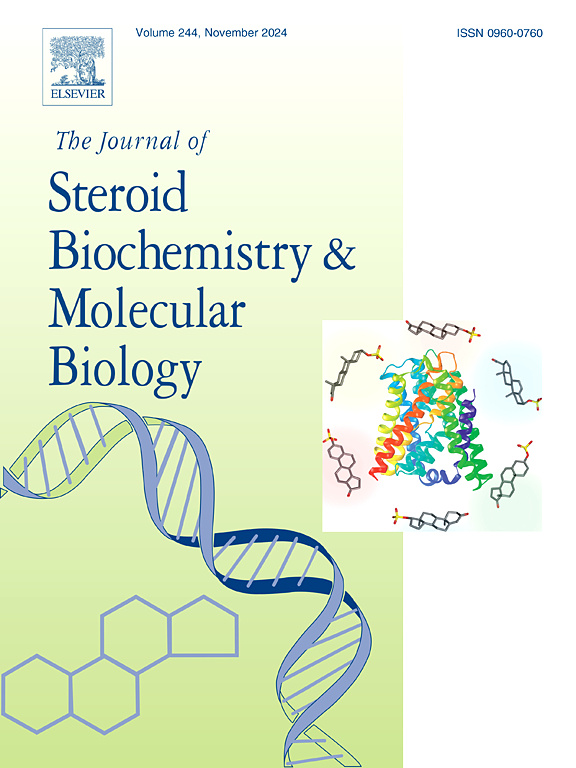Combined inhibition of importin-β and PBR enhances osteogenic differentiation of BMSCs by reducing nuclear accumulation of glucocorticoid receptor and promoting its mitochondrial translocation
IF 2.7
2区 生物学
Q3 BIOCHEMISTRY & MOLECULAR BIOLOGY
Journal of Steroid Biochemistry and Molecular Biology
Pub Date : 2025-03-11
DOI:10.1016/j.jsbmb.2025.106731
引用次数: 0
Abstract
Excessive buildup of endogenous glucocorticoids has been closely linked to postmenopausal osteoporosis (PMOP), though the underlying mechanisms remain unclear. This study examines the role of glucocorticoid receptor (GR) signaling in PMOP, particularly its translocation to mitochondria, interaction with the peripheral benzodiazepine receptor (PBR), and impact on bone formation. In vitro, primary bone marrow mesenchymal stem cells (BMSCs) from mice were cultured to induce osteogenesis under varying concentrations of dexamethasone. Nuclear GR, mitochondrial GR, and PBR levels were measured, along with the effects of Importazole, an importin-β inhibitor, and Emapunil, a PBR inhibitor, on osteogenic differentiation. In vivo, ovariectomized mice were treated with Importazole and Emapunil to assess their anti-osteoporotic potential. Our results indicate that ovariectomized mice displayed increased nuclear GR, decreased mitochondrial GR, and elevated PBR expression in BMSCs. High dexamethasone impaired osteogenic differentiation, characterized by nuclear GR accumulation, reduced mitochondrial translocation, and increased PBR expression. Co-immunoprecipitation confirmed a direct interaction between mitochondrial GR and PBR. Importazole reduced nuclear GR levels, promoting bone formation and alleviating osteoporosis, while Emapunil enhanced GR mitochondrial translocation, improved mitochondrial function, and strengthened bone health. Combined, Importazole and Emapunil showed superior anti-osteoporotic effects compared to either treatment alone. These findings suggest that estrogen deficiency promotes nuclear GR accumulation and PBR expression in BMSCs, limiting GR mitochondrial translocation and reducing osteogenic differentiation. Combining Importazole and Emapunil could mitigate these effects, offering a promising therapeutic strategy for PMOP.
联合抑制输入蛋白-β和PBR通过减少糖皮质激素受体核积累和促进其线粒体易位促进骨髓间充质干细胞成骨分化。
内源性糖皮质激素的过度积累与绝经后骨质疏松症(PMOP)密切相关,尽管其潜在机制尚不清楚。本研究探讨了糖皮质激素受体(GR)信号在PMOP中的作用,特别是其向线粒体的易位,与外周苯二氮卓受体(PBR)的相互作用,以及对骨形成的影响。体外培养小鼠原代骨髓间充质干细胞(BMSCs),在不同浓度地塞米松作用下诱导成骨。测量核GR、线粒体GR和PBR水平,以及Importazole(一种进口蛋白β抑制剂)和Emapunil(一种PBR抑制剂)对成骨分化的影响。体内用Importazole和Emapunil治疗去卵巢小鼠,观察其抗骨质疏松的作用。我们的研究结果表明,去卵巢小鼠显示出核GR增加,线粒体GR降低,骨髓间充质干细胞中PBR表达升高。高地塞米松损伤成骨分化,其特征是核GR积累,线粒体易位减少,PBR表达增加。共免疫沉淀证实了线粒体GR和PBR之间的直接相互作用。Importazole降低核GR水平,促进骨形成,缓解骨质疏松症,Emapunil增强GR线粒体易位,改善线粒体功能,增强骨骼健康。与单独治疗相比,Importazole和Emapunil联合治疗显示出更好的抗骨质疏松效果。这些结果表明,雌激素缺乏促进骨髓间充质干细胞中核GR积累和PBR表达,限制GR线粒体易位,减少成骨分化。Importazole与Emapunil联用可以减轻这些影响,为ppu治疗提供了一种很有前景的治疗策略。
本文章由计算机程序翻译,如有差异,请以英文原文为准。
求助全文
约1分钟内获得全文
求助全文
来源期刊
CiteScore
8.60
自引率
2.40%
发文量
113
审稿时长
46 days
期刊介绍:
The Journal of Steroid Biochemistry and Molecular Biology is devoted to new experimental and theoretical developments in areas related to steroids including vitamin D, lipids and their metabolomics. The Journal publishes a variety of contributions, including original articles, general and focused reviews, and rapid communications (brief articles of particular interest and clear novelty). Selected cutting-edge topics will be addressed in Special Issues managed by Guest Editors. Special Issues will contain both commissioned reviews and original research papers to provide comprehensive coverage of specific topics, and all submissions will undergo rigorous peer-review prior to publication.

 求助内容:
求助内容: 应助结果提醒方式:
应助结果提醒方式:


